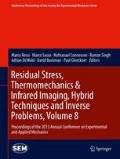Abstract
Layered specimens can, and often do, have discontinuities in residual stress across the material interfaces. Stress discontinuities internal to specimens are notoriously difficult to measure, yet they can have profound impact on debonding and other failures. The incremental slitting method, also known as crack compliance, is generally excellent at resolving stress profiles even when there are high gradients. However, the data reduction for slitting usually involves some smoothing, which makes it hard to resolve discontinuities. In this work, we start with a recent technique to analyze slitting data using Tikhonov regularization, and extend that technique to allow stress discontinuities at material interfaces. The new method is then demonstrated experimentally on several specimens, including metals and ceramics.
Access this chapter
Tax calculation will be finalised at checkout
Purchases are for personal use only
Notes
- 1.
See [14] for general formulas for unevenly spaced intervals.
References
Withers PJ (2007) Residual stress and its role in failure. Rep Prog Phys 70(12):2211–2264
James MN (2011) Residual stress influences on structural reliability. Eng Fail Anal 18(8):1909–1920
Cheng W, Finnie I (2007) Residual stress measurement and the slitting method, Mechanical engineering series. Springer Science + Business Media/LLC, New York
Hill MR (2013) The slitting method. In: Schajer GS (ed) Practical residual stress measurement methods. Wiley, Chichester
Wong W, Hill MR (2012) Superposition and destructive residual stress measurements. Exp Mech 53(3):339–344. doi:10.1007/s11340-012-9636-y
Aydiner CC, Ustundag E, Prime MB, Peker A (2003) Modeling and measurement of residual stresses in a bulk metallic glass plate. J Non-Cryst Solids 316(1):82–95
Prime MB, Hill MR (2004) Measurement of fiber-scale residual stress variation in a metal-matrix composite. J Compos Mater 38(23):2079–2095
Rankin JE, Hill MR (2003) Measurement of thickness-average residual stress near the edge of a thin laser peened strip. J Eng Mater Technol 125(3):283–293
Cheng W, Finnie I (1985) A method for measurement of axisymmetric axial residual stresses in circumferentially welded thin-walled cylinders. J Eng Mater Technol 107(3):181–185
Gremaud M, Cheng W, Finnie I, Prime MB (1994) The compliance method for measurement of near surface residual stresses-analytical background. J Eng Mater Technol 116(4):550–555
Cheng W, Finnie I, Gremaud M, Rosselet A, Streit RD (1994) The compliance method for measurement of near surface residual stresses-application and validation for surface treatment by laser and shot-peening. J Eng Mater Technol 116(4):556–560
Finnie S, Cheng W, Finnie I, Drezet JM, Gremaud M (2003) The computation and measurement of residual stresses in laser deposited layers. J Eng Mater Technol 125(3):302–308
Ersoy N, Vardar O (2000) Measurement of residual stresses in layered composites by compliance method. J Compos Mater 34(7):575–598
Schajer GS, Prime MB (2006) Use of inverse solutions for residual stress measurements. J Eng Mater Technol 128:375–382
Hill MR, Van Dalen JE, Prime MB (2011) Assessment of residual stress in fracture mechanics coupons. In: Proceedings of the 2011 Pressure Vessels and Piping Conference, Baltimore, Maryland, USA, July 17–21, 2011, ASME inc., doi:10.1115/PVP2011-57768
Schajer GS (1988) Measurement of non-uniform residual-stresses using the hole-drilling method 1. Stress calculation procedures. J Eng Mater Technol 110(4):338–343
Tikhonov AN, Goncharsky A, Stepanov V, Yagola AG (1995) Numerical methods for the solution of ill-posed problems. In: Hazewinkel M (ed) Mathematics and its applications. Vol. 328. Springer Netherlands
Lee MJ, Hill MR (2007) Effect of strain gage length when determining residual stress by slitting. J Eng Mater Technol 129(1):143–150
Rankin JE, Hill MR, Hackel LA (2003) The effects of process variations on residual stress in laser peened 7049 T73 aluminum alloy. Mater Sci Eng A A349(1/2):279–291
Simulia Abaqus 5.12-1 (2012) Dassualt systems
Wachs DM, Clark CR, Dunavant RJ (2008) Conceptual process description for the manufacture of low-enriched uranium-molybdenum fuel. Idaho National Laboratory report INLIEXT-08-13840
Crapps J, Clarke K, Katz J, Alexander DJ, Aikin B, Vargas VD, Montalvo JD, Dombrowski DE, Mihaila B (2013) Development of the hot isostatic press manufacturing process for monolithic nuclear fuel. Nucl Eng Des 254:43–52
Shin H, Case E, Kwon P (2003) Fabrication of internal channels in ceramics and ceramic composites. J Adv Mater 35(2):28–35
Case ED, Ren F, Kwon P, Kok CK, Rachedi R, Klenow B (2005) Machining and ceramic/ceramic joining to form internal mesoscale channels. Int J Appl Ceram Technol 1(1):95–103
Sun L, Kwon P (2010) ZrW2O8–ZrO2 continuous functionally graded materials fabricated by in situ reaction of ZrO2 and WO3. J Am Ceram Soc 93(3):703–708
Ekbote B, Kwon P, Prime MB (2006) Micromechanics-based design and processing of efficient meso-scale heat exchanger. In: Mallick PK (ed) Proceedings of the American society for composites – 21st technical conference, Dearborn, 2006
Alexander DJ, Clarke KD, Liu C, Lovato ML (2011) Tensile properties of 6061 aluminum alloy materials. Los Alamos National LAboratory report LA-UR-11-06707
Acknowledgments
This work was performed at Los Alamos National Laboratory, operated by the Los Alamos National Security, LLC for the National Nuclear Security Administration of the U.S. Department of Energy under contract DE-AC52-06NA25396. By acceptance of this article, the publisher recognizes that the U.S. Government retains a nonexclusive, royalty-free license to publish or reproduce the published form of this contribution, or to allow others to do so, for U.S. Government purposes. The authors would like to acknowledge the financial support of the US Department of Energy- National Nuclear Security Administration’s Global Threat Reduction Initiative’s Reactor Conversion program.
Author information
Authors and Affiliations
Corresponding author
Editor information
Editors and Affiliations
Rights and permissions
Copyright information
© 2014 The Society for Experimental Mechanics, Inc.
About this paper
Cite this paper
Prime, M.B., Crane, D.L. (2014). Slitting Method Measurement of Residual Stress Profiles, Including Stress Discontinuities, in Layered Specimens. In: Rossi, M., et al. Residual Stress, Thermomechanics & Infrared Imaging, Hybrid Techniques and Inverse Problems, Volume 8. Conference Proceedings of the Society for Experimental Mechanics Series. Springer, Cham. https://doi.org/10.1007/978-3-319-00876-9_12
Download citation
DOI: https://doi.org/10.1007/978-3-319-00876-9_12
Published:
Publisher Name: Springer, Cham
Print ISBN: 978-3-319-00875-2
Online ISBN: 978-3-319-00876-9
eBook Packages: EngineeringEngineering (R0)

